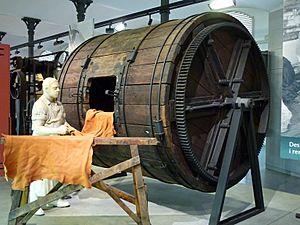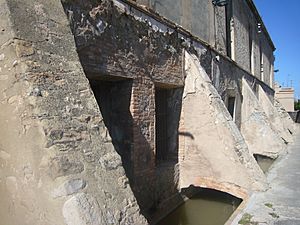Igualada Leather Museum facts for kids
The Igualada Leather Museum (Catalan: Museu de la Pell d'Igualada) is a super cool place in Igualada, Catalonia, Spain. It opened way back in 1954! This museum was the very first leather museum in Spain. It was also the third one of its kind in all of Europe. The museum shows off its amazing collections in two buildings. These buildings are close to each other in Igualada. One is the "Cal Boyer" building, which used to be a cotton factory from the late 1800s. The other is the "Cal Granotes" building, an old leather-making factory (called a tannery) from the 1700s.
Contents
Exploring the Leather Museum at "Cal Boyer"
The main part of the Leather Museum is in the "Cal Boyer" building. This building is the heart of the museum. It's a special and unique museum, one of the top three in Europe for its kind.
The museum has three main areas to explore. These are "leather in history," "a world of leather," and "industrialization."
Leather Through Time
The first area, "leather in history," shows how leather has been used. It also explains its importance in the Mediterranean region. You can learn about leather from ancient times, like prehistory. It covers how animal hides were turned into leather (called tanning). You'll see how leather was used in ancient Greece and ancient Rome. There are also cool displays about parchment (animal skin used for writing) and bookbinding. You can learn about special leather types like shell cordovan. The museum also shows guadamecil, which is an old way of decorating leather with paint or gold. Plus, you'll see how traditional jobs like shoemakers and people who make horse tack (horse gear) used leather.
A World of Leather
The second area, "A world of leather," explores different ways leather is part of our lives. It shows how leather is used in sports, war, and travel. You can learn about how nomads (people who move around) used leather. It even explores the sounds leather can make and how it feels to touch. There are videos and five interactive games here. These games let you discover how leather feels, sounds, how strong it is, if it lets water through, and how it can be drilled.
How Leather Making Became Modern
The third area is "industrialization." This part shows how leather making changed over time. It's like the end of a journey that starts in the old "Cal Granotes" tannery. This section has three main steps. First, it shows how leather was made in Igualada around 1890. This was a step up from the old hand-made methods at "Cal Granotes." Next, you see the first machines used in leather making. Finally, it shows the modern industrial way of making leather. This is when machines really took over. You'll see how old ways of treating leather in holes were replaced by modern barrels. It shows how work changed from being done by hand to using advanced machines powered by electricity.
Discovering the "Cal Granotes" Tannery
The "Cal Granotes" tannery is a very special exhibit. It's about 100 meters away from the "Cal Boyer" building. It opened to visitors in December 1990. This tannery is in a very old neighborhood called "El Rec." This area is built along a ditch that has always provided water for many tanneries. The "Cal Granotes" building is from the 1700s. It has been fixed up to show exactly how leather was made long ago. The building still looks like it did back then. It shows three old ways of tanning ox and cow leather. This leather was mostly used for making shoe soles. These methods included leather sewing, an old Moroccan system, and a newer Moroccan system.
The "Cal Granotes" tannery shows two floors of a typical old leather factory. The ground floor was where the leather was prepared and tanned. The upper floor was where the leather was hung up to dry. Most of the leather made here was for shoe soles. But it was also used for other things. This included leather horse harness for animals and horse-drawn carriages. It was also used for chair backs and seats. Later, it was used to make belts for steam-powered factories.
In the early 1700s, leather workers in Igualada moved their businesses. They left the old medieval town walls. They built new factories along a water channel called "El Rec." This ditch was mentioned in documents from the 1100s! It was used by mills even before the tanneries. The ditch is 3049 meters long. It gets its water from the Anoia river through a special gate called a lock.
People and Water at Cal Boyer
This exhibition opened in 1991 inside the Cal Boyer building. It helps you understand how water is connected to people's lives. The exhibition has several parts. It shows how water is lifted, how it's used in homes, what water actually is, how water affects our health, and how water is used for business. In 1992, this exhibition won a special award called the "FAD prize" for its amazing design.
The theme of water is also shown with a big steam engine and a noria. A noria is a water wheel. These machines show how water can be turned into energy. They are machines from the old "Cal Boyer" cotton factory. A mud noria has also been fixed up. This type of noria used to lift water to a higher level for irrigation (watering crops).
Images for kids
See also
 In Spanish: Museo de la Piel de Igualada para niños
In Spanish: Museo de la Piel de Igualada para niños
- Igualada Muleteer's Museum
- German Leather Museum
- Walsall Leather Museum







